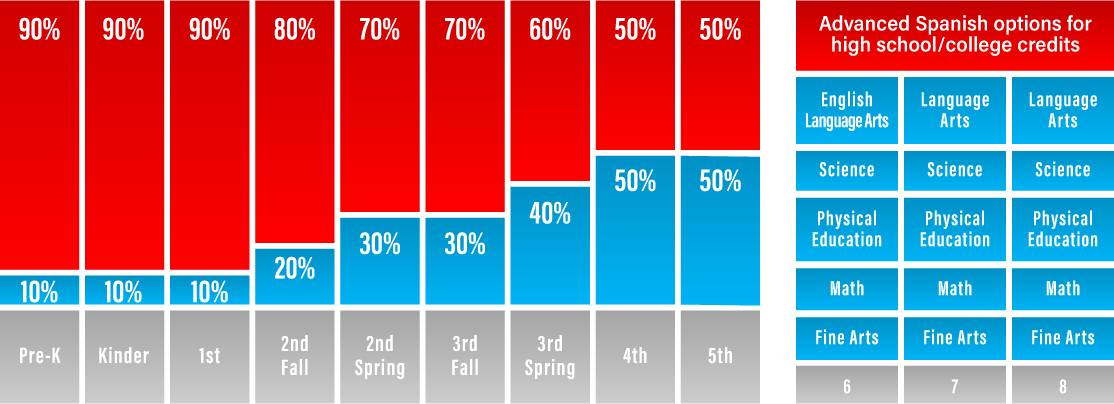In Northside, we offer the Dual Language Immersion two-way program model which is research-based and is designed in accordance with Chapter 89 Commissioner’s rules. The program seeks to create bilingual, biliterate, and bicultural students by developing their academic proficiency in English and Spanish.
En Northside, ofrecemos el programa de doble inmersión cual se apoya en investigación y está diseñado de acuerdo con las reglas del Comisionado del Capítulo 89. El programa busca crear estudiantes bilingües, alfabetizados y biculturales mediante el desarrollo de su competencia académica en Inglés y Español.
Dual Language Immersion Campuses / Escuelas de Doble Inmersión
PK Available
- Burke
- Esparza
- Fisher
- Howsman
- Leon Valley
- Myers
- Passmore
- Villarreal
Kinder-1st
- Henderson
Kinder-2nd
- Fields
- Kallison
- Reed
Kinder-3rd
- Carlos Coon
- Cody
- Driggers
- Los Reyes
Kinder-4th
- Allen
- Cable
- Mary Hull
Kinder-5th
- Burke
- Cole
- Ellison
- Esparza
- Fisher
- Glenn
- Forester
- Howsman
- Knowlton
- Langley
- Leon Valley
- Martin
- May
- Mora
- Myers
- Passmore
- Villarreal
- Wanke
- Ward
- Westwood Terrace
NISD Dual Language Parent Information Sessions
NISD Reuniones Informativas para Padres del Program de Doble Inmersión
2025
The following is a list of community informational meetings hosted by each campus for families interested in learning more about the NISD Dual Language program.
La siguiente lista de reuniones informativas están organizadas por cada escuela para proveer información sobre el programa de NISD de doble inmersión.
Dual Language Immersion Program
Dual Language Application Process (English/Español)
This is a general timeline. Some of these dates are subject to change based on District recommendations and individual campus resources. New Dual Language Immersion applicants must first register their student online at their Northside ISD attendance zone campus before completing the application.
Este es un calendario general. Algunas fechas están sujetas a cambios según las recomendaciones del Distrito y los recursos individuales de cada escuela. Los nuevos solicitantes para el programa de doble inmersión primero deben registrar a su estudiante en su escuela asignada de Northside ISD según la zona de asistencia antes de completar la solicitud.
New Dual Language Applicants: Register your student online to their Northside ISD home campus - according to home address.
January 31
- Applications for participation in the program will become available on the NISD Dual Language website.
https://duallang.nisd.net

April 25
- The Dual Language Lottery will take place.
- Applications will continue to be accepted.
- Placement will be considered based on space availability at individual campuses.
May 5 - 9
- Dual Language campuses will use the lottery results to start creating their class list.
- Schools will communicate to Group 1 families about acceptance and notify waitlist status.

May 12 - 29
- Campuses will continue to work to finalize their dual language class rosters.
- Spaces available for Groups 2 and 3 will be determined and communicated to families.

Nuevos solicitantes del programa: registre a su estudiante en línea en su campus de origen de Northside ISD, de acuerdo con la dirección de su hogar.
31 de enero
- La solicitud para participar en el programa de doble inmersion estará disponible en el sitio web de
https://duallang.nisd.net

25 de abril
- Se llevará a cabo la lotería del programa de doble inmersion.
- Se seguirán aceptando solicitudes.
- La ubicación se considerará según la disponibilidad de espacio en los escuelas individuales.
5-9 de mayo
- Las escuelas del programa de doble inmersion utilizarán los resultados de la lotería para crear su lista de clases.
- Las escuelas comunicarán a las familias de grupo 1 sobre la aceptación al programa y el estado de la lista de espera.

12 al 29 de mayo
- Los escuelas continuarán trabajando para finalizar sus listas de clases para el programa de doble inmersion.
- Las plazas disponibles para grupos 2 y 3 se determinarán y comunicarán a las familias.

Pre-Kinder families can register starting April 1, 2025 using the same application link. Students must first register at their assigned home campus and meet eiligibility requierments for Pre-K. Please contact your school for specific Pre-Kinder registration dates.
Las familias de Pre-Kinder pueden registrarse a partir del 1 de abril de 2025 utilizando el mismo enlace de solicitud. Los estudiantes primero deben registrarse en su escuela asignada segun su domicilio y cumplir con los requisitos de elegibilidad para Pre-K. Comuníquese con su escuela para conocer las fechas específicas de inscripción de Pre-Kinder.
Frequently Asked Questions about Dual Language
Dual Language Two Way Immersion (TWI) is an educational model that integrates native English speakers and native speakers of another language for all or most of the day, with the goals of promoting high academic achievement, first-and-second-language development and cross-cultural understanding for all students. In DL TWI programs, language learning takes place primarily through content instruction. Academic subjects are taught to all students through both English and the non-English language. As students and teachers work together to perform academic tasks, the students’ language abilities are developed along with their knowledge of content area subject matter.
In most cases, learning another language enhances a child’s English ability. Children can learn much about English by learning the structure of another language. Common vocabulary also helps children learn the meaning of new words in English. Experimental studies have shown that no long-term delay in native English language development occurs in children participating in second language classes, even in full immersion programs.
In fact, children enrolled in foreign language programs score statistically higher on standardized test conducted in English. A number of reports have demonstrated that children who have learned a second language earn higher SAT scores, particularly on the verbal section of the test. One study showed that, by the fifth grade of an immersion program, students outperformed all comparison groups and remained high academic achievers throughout their schooling.
Concepts learned in either language become a part of the child’s general knowledge. Many language concepts transfer from one language to another.
Please see the following websites for more information on current research in language learning:
Yes, the TWI curriculum follows the same District guidelines and standards. TWI classes cover the same grade level objectives, as do regular English classes. Students work toward the same academic goals regardless of the language of instruction.
The school realizes that many parents are monolingual and will answer your questions/concerns in English. Homework instructions will be given in both languages and will consist of previously taught material. It is important that you continue to develop English language skills to a high degree to increase your child’s ability to transfer that knowledge and skills into their development of Spanish.
Depending on the advancement of your child in the program, he or she will fit into a regular English classroom. We discourage parents from removing children from the program prematurely as, this may have negative cognitive affects. Once children have spent 4-5 years in the program they will be able to function in an all English classroom, however, the cognitive benefits that come from participating in a dual language classroom require a minimum of 5-6 years. Now that DL programs exist in many school districts and schools within NISD, you may be able to find one in your new neighborhood and can transfer your child to that school pending space availability.
In addition to the report card, there is also communication with parents through newsletters, parent-teacher conferences, special notices, email and phone calls. Parents are welcome to visit classes with prior teacher notification. Furthermore, parents get annual reports on their child’s language progress in English and Spanish based on the LAS Links evaluation, which is the same evaluation used to generate a baseline score for their children when they first begin their studies in the dual language program.
Teachers use many strategies to make the content understandable, such as visuals, props, manipulatives, facial expressions, gestures, physical movements and many other instructional techniques. The teachers also repeat vocabulary and concepts and always check for understanding. Teachers do not expect your child to speak the second language right away. The students are not forced to speak the second language and they are initially allowed to speak English/Spanish. The teacher will restate what your child says to reinforce connection between the Spanish and English vocabulary or vice versa.
Encourage your child by telling him/her how proud you are that he/she is learning a second language. Let your child know you are proud of his/her progress. Show him/her that you value the ability to speak a second language. Here are some suggestions on how parents can help:
- Encourage your child’s interest in the language and other cultures.
- Attend cultural events that feature the music, dance or food from the country where the language is spoken.
- Provide books, videos, and other materials in the second language.
- Be actively involved in your child’s school.
- Teach your child the songs and nursery rhymes from his/her own heritage.
- Read stories to your child in English/Spanish.
- Encourage, but do not force your child to speak the second language at home.
- Get to know your child’s teacher either by phone, email or personal visits.
- Take time to get involved with school activities.
- Keep informed of DL programs.
- Be supportive at all times of your child, the program and the teacher.
Do not expect your child to start speaking the second language after the first few weeks. He/she is in the listening phase of his/her second language development. Your child will become familiar with vocabulary and then will begin to take the steps to speak the second language. Do NOT compare your child to other DL students. Learning a second language is a five to seven year process, and each child develops at his/her rate. Follow this link to the five stages of language acquisition.
Do not feel discouraged if, at the beginning, your child cries or seems nervous about the experience. Your child will need some time to adjust to this new challenge. From the start, the students are made to feel secure. Be patient. By the end of the first month, most of the students are over the initial adjustment. When your child comes home, do not be upset if he/she does not feel like telling you about his/her day at school. Children often are very tired after their day and are in need of a change once they get home. If you feel that your child is continuously experiencing anxiety, it would be wise to discuss this issue
Bilingual office does program transfer for students in DL; Campus submits parent choice transfer for siblings to Office of Student Advocacy and School Choice; If denied, then campus submits admin transfer in efforts to keep the family together. Principal submits to central office Administrative Dept.
PK-8 Trajectory Framework

NISD Dual Language Trajectory - A strong foundation in Spanish is required for overall success in secondary classes, which at the middle school level include advanced Spanish courses.